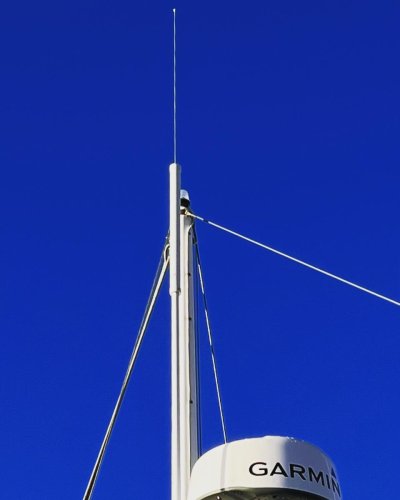Pat T
Senior Member
- Joined
- Sep 6, 2019
- Messages
- 215
- Location
- United States
- Vessel Name
- Moondance
- Vessel Make
- Grand Banks CL 42
Never had to replace a VHF or antenna till now. So, I already purchased 2 Shakespeare Galaxy 6dB antennas, model 5399, and 2 ft extensions. This will closely match the height of my current set up. Looking at replacing older Icom radios with new Icoms (want to match my current cut-outs). Below is from Icom manual and I am a bit concerned.
The installation of this equipment should be made in such a
manner as to respect the EC recommended electromagnetic
field exposure limits. (1999/519/EC)
The maximum RF power available from this device is 25
watts. The antenna should be installed as high as possible
for maximum efficiency and the installation height should be
at least 1.76 meters above any accessible position. In the
case where an antenna cannot be installed at a reasonable
height, then the transmitter should neither be continuously
operated for long periods if any person is within a distance
of 1.76 meters of the antenna, nor operated at all if any
person is touching the antenna.
It is recommended that antenna of a maximum gain of
3 dB is used. If higher gain antenna are required then
please contact your Icom distributor for revised installation
recommendations.
My antennas are mounted to each side of the flybridge and are not 1.76 meters (5.77 ft) above said height. They are pretty much right next to me and I've seen plenty flybridge boats set up the same way. Are we all shortening our lives here or are we ok in that we are not transmitting all that much?
My new antenna is 6dB not the 3dB recommended by Icom. All the other 3dB antennas were smaller in height. If I decide on purchasing this new radio what would be the revised installation recommendations? Or should I look for a new radio that recommends a 6dB antenna?
Appreciate your inputs.
The installation of this equipment should be made in such a
manner as to respect the EC recommended electromagnetic
field exposure limits. (1999/519/EC)
The maximum RF power available from this device is 25
watts. The antenna should be installed as high as possible
for maximum efficiency and the installation height should be
at least 1.76 meters above any accessible position. In the
case where an antenna cannot be installed at a reasonable
height, then the transmitter should neither be continuously
operated for long periods if any person is within a distance
of 1.76 meters of the antenna, nor operated at all if any
person is touching the antenna.
It is recommended that antenna of a maximum gain of
3 dB is used. If higher gain antenna are required then
please contact your Icom distributor for revised installation
recommendations.
My antennas are mounted to each side of the flybridge and are not 1.76 meters (5.77 ft) above said height. They are pretty much right next to me and I've seen plenty flybridge boats set up the same way. Are we all shortening our lives here or are we ok in that we are not transmitting all that much?
My new antenna is 6dB not the 3dB recommended by Icom. All the other 3dB antennas were smaller in height. If I decide on purchasing this new radio what would be the revised installation recommendations? Or should I look for a new radio that recommends a 6dB antenna?
Appreciate your inputs.


